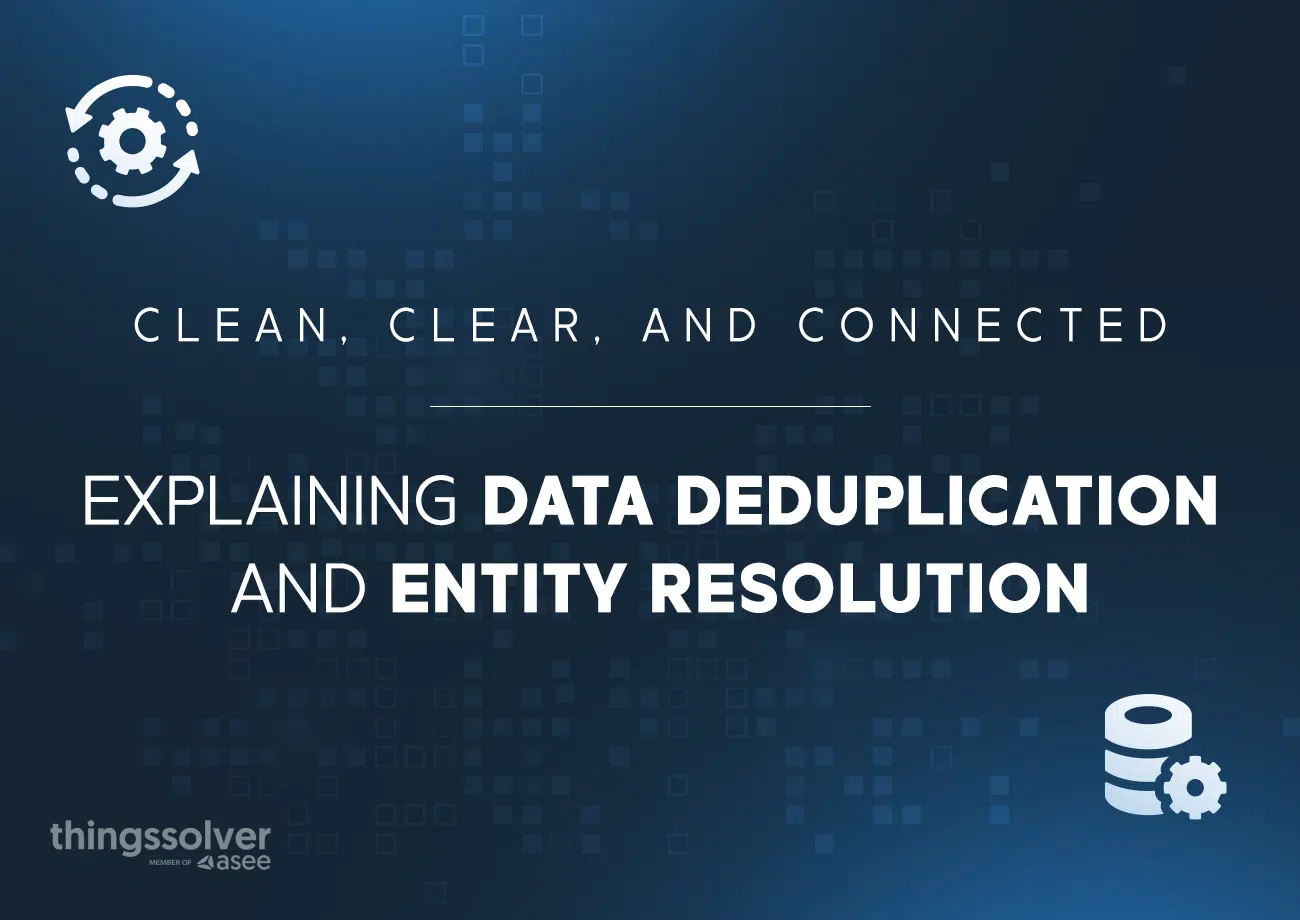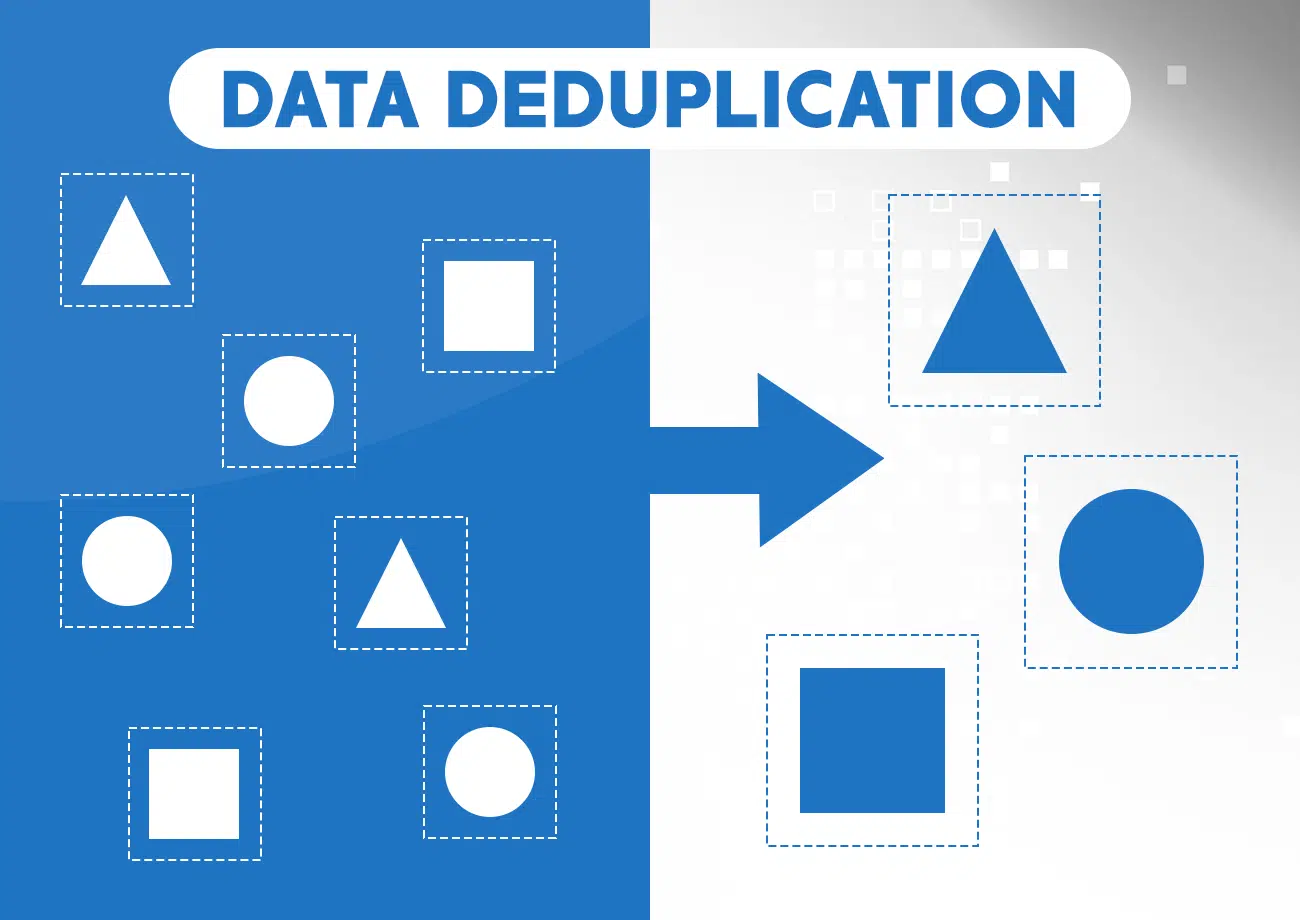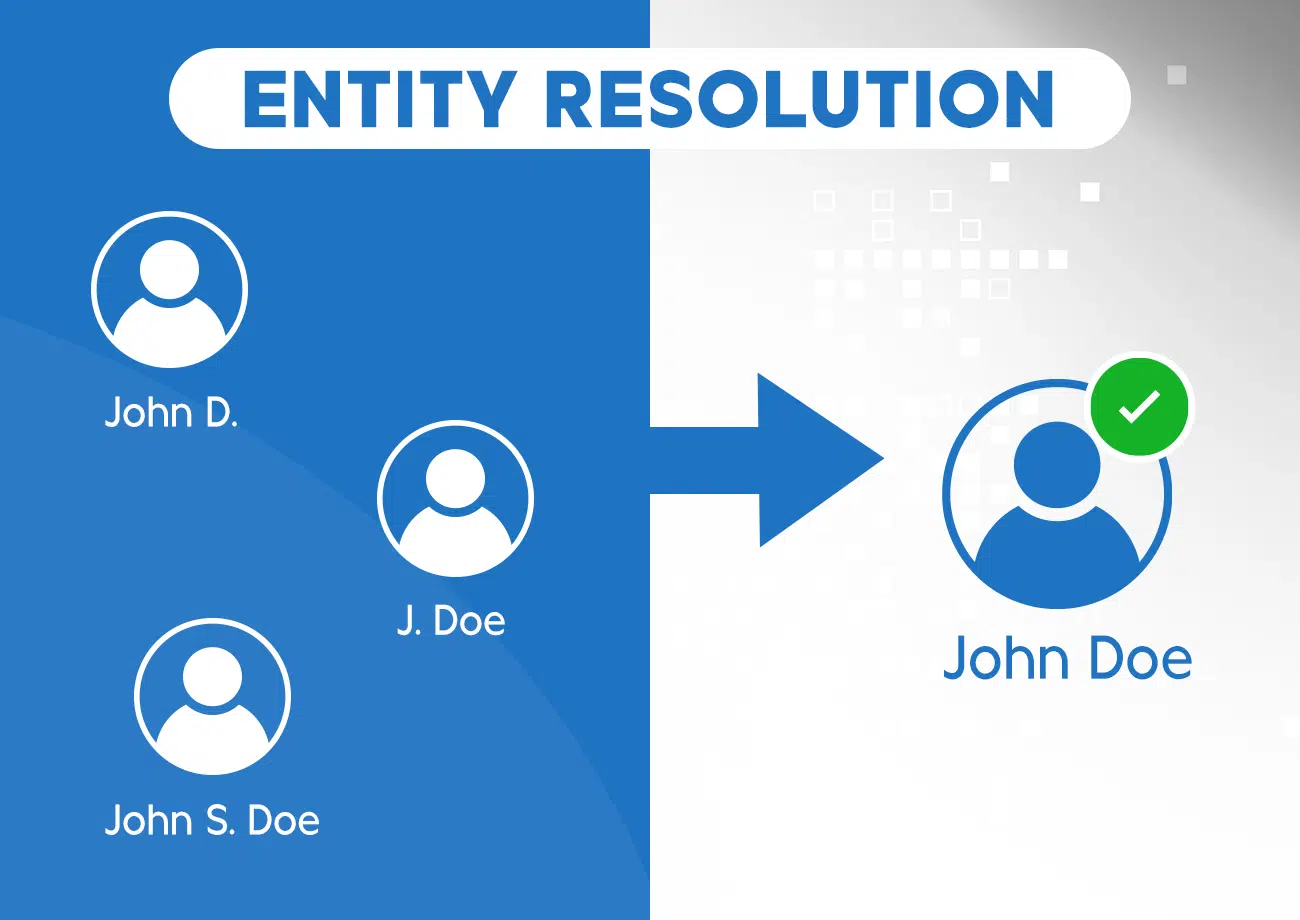In today’s data-driven business landscape, effective Master Data Management is key.
The amount of data enterprises generate and collect is growing at unprecedented speed.
Everyone agrees that data can deliver the edge a business needs to be successful.
However, the requirement to be data-driven has pushed many businesses to frantically acquire as much data as possible without paying much attention to the usability of the acquired data.
So, we now have businesses sitting on enormous amounts of disparate and unreliable data scattered across many different platforms, teams, and services – but little value or insights.
The key struggle most businesses face is cleaning and consolidating all this data into a coherent and powerful business asset.
In today’s blog post, we will:
- Briefly explain Master Data Management,
- Define Data Deduplication and Entity Resolution,
- Discuss the negative consequences of poor Master Data Management, and
- Provide concrete tips for connecting disparate data sources, deduplicating extensive data sets, and enriching your data.
Let’s start!
What is Master Data Management (MDM)?
Master Data Management is the process of creating unified, accurate, and consistent data. It is a holistic approach that considers all available data and works towards building a single master record for each entity in the data.
MDM typically includes essential business information such as:
- Customer data,
- Product data,
- Vendor data,
- Employee data, and
- Other core entities that are shared across an organization.
MDM is crucial for business success – it provides a solid foundation for data-driven decision-making, operational efficiency, and compliance.
Two key components of the Master Data Management process are deduplication and entity resolution. Let’s explain the two concepts briefly.
Understanding Deduplication
Deduplication refers to identifying and eliminating duplicate or redundant records within a certain dataset. This process involves comparing data entries and determining which records represent the same entity.
Additionally, there are two deduplication techniques you can implement to eliminate duplicate data:
- The first is rule-based, where you set specific criteria to identify duplicates,
- The second is machine learning-based, where algorithms learn patterns and similarities to identify duplicate records.
Whichever technique you choose, the goal of deduplication is to ensure data accuracy, improve data quality, and prevent redundant or inconsistent information.
Understanding Entity Resolution
Entity resolution, also known as record linkage or entity matching, is the process of identifying and linking records that correspond to the same real-world entity across different data sources.
Thanks to entity resolution, you can determine if two or more records refer to the same individual, customer, or product.
Entity resolution techniques use various algorithms and similarity measures to compare data attributes and identify relationships or similarities between records.
The goal of entity resolution is to create a single, comprehensive view of an entity by linking and merging related records from disparate sources. This helps eliminate redundancy, consolidate information, and ensure data consistency and accuracy.
–
Overall, deduplication focuses on identifying and removing duplicate records within a dataset, while entity resolution aims to link and merge records representing the same real-world entity across different data sources.
Both processes are essential for achieving data quality, integrity, and a unified view of entities within a data management framework.
What happens if you don’t handle your data properly?
The negative consequences of poor data management
Real-world data is complex and has to be managed properly.
In the business context, not handling data properly can lead to serious consequences such as:
- Poor customer experience and customer service,
- Increased marketing costs,
- Misleading reporting and decision-making, and
- Hundreds of wasted hours for manual reconciliation.
To help you understand the downsides of the poor MDM process, let’s look at one example.
An example of poor Master Data Management
A business has a centralized CRM solution that contains data about all of its customers. Over the years, the CRM has been filled with data from various sources such as:
- Different business verticals,
- External integrations,
- Website forms, etc.
Although most CRM solutions provide some form of duplicate handling, these processes mostly struggle with anything beyond basic rule-based deduplication and can perform only with limited amounts of data.
On top of this, even these basic processes could be skipped due to the origin and method of how the data was imported, human error, etc.
This could lead to having records such as those in the table below:
- There are two Jane Does – both are Data Engineers who live in New York and have the same number.
- There are also two John Smiths who come from Tempe and work in the same company.
To the human eye, it is fairly obvious that we are dealing with two sets of duplicate records.
However, these customer records don’t share enough identical features which makes it really difficult to apply a simple rule-based process for deduplication and entity resolution.
Now imagine having a data set with hundreds of thousands or even millions of records – the complexity of the problem can rise exponentially.
So, how can you improve your MDM process and remove the possibility of duplicate records and redundant information?
Tips for implementing Data Deduplication and Entity Resolution
If your company isn’t handling data in the right way, you can lose a lot of time, money, and ultimately customers. What you need instead is a suitable MDM approach based on data deduplication and entity resolution.
When we are talking about more effective data management, you should make sure to approach this from three different aspects:
- Connecting disparate data sources,
- Deduplicating extensive data sets, and
- Enriching data.
Here are a few tips on how to address each aspect.
How to connect disparate data sources
Connecting different data sources helps you gain a comprehensive and unified view of data. This also helps with facilitating accurate analysis and informed decision-making across your organization.
How can you connect disparate data sources?
- Data integration platforms: Invest in data integration platforms or tools that can harmonize and consolidate data from various sources, ensuring a unified view of your data.
- APIs and web services: Use APIs and web services to establish connections between different systems and applications. This way, you can enable seamless data exchange and real-time updates.
- Data warehousing: You can also implement a data warehouse to centralize and store data from diverse sources. If you want to provide a single source of truth for analysis and reporting, this is the way.
- Data virtualization: Consider data virtualization techniques to access and analyze data from multiple sources without physically moving or replicating it.
These are some of the ways to connect disparate data sources. Now is the time to remove duplicates. Let’s see how.
How to deduplicate extensive data sets
Removing redundant and duplicate data is important because it can:
- Reduce storage costs,
- Optimize data efficiency, and
- Ensure accurate and reliable information across systems.
Here are a few tips to implement:
- Data profiling: If you conduct data profiling, you can easily identify duplicate records and understand the extent of duplication within your datasets.
- Data matching algorithms: Implement some advanced data matching algorithms like fuzzy matching or phonetic matching. This can help you detect and merge duplicate records based on specific attributes.
- Manual review: Assign data experts to manually review potential duplicates and make informed decisions about their consolidation.
- Automated data deduplication: Use automated data deduplication tools to streamline the process and reduce human errors.
Hopefully, some of these tips will prove helpful to you. Let’s see what you can do to enrich your data.
How to enrich your data
This step is important because it enhances the value and quality of your information by incorporating additional relevant details, context, and external data sources.
Here are a few ideas:
- Third-party data sources: Integrating relevant data from reputable third-party sources can help augment your existing data with additional information, such as demographic data, firmographics, or geospatial data.
- Data enrichment services: To ensure data accuracy and completeness, you can leverage data enrichment services that can enhance your data with standardized and validated information.
- User-generated content: Encourage user-generated content, such as reviews, ratings, and feedback, to enrich your data with valuable customer perspectives.
- Machine learning and AI: Utilize machine learning and AI algorithms to analyze and enrich your data with insights, predictions, or sentiment analysis.
Ultimately, successful data management should be based on a thoughtful strategy and the right tools. But you should also make sure to validate the quality and accuracy of your data before incorporating it into your MDM process.
If you truly want to maintain the integrity and usefulness of your data over time, you should conduct regular data maintenance, too.
How can Things Solver help you handle data more effectively?
At Things Solver, we know how hard it can be to find a suitable data management solution that handles data duplication effectively.
Imagine having 25% duplicate records in your datasets.
Now, stop and think about how much money you’re wasting on redundant communication with customers every month. Not only does this affect your budget, but it also leads to poor customer experience and negative brand perception. These 25% are impacting your critical reporting needs and your decision-making.
But, with our custom-made solutions, you could do much better.
Things Solver’s AI and ML-based entity resolution model
Wanting to help businesses handle these data duplication and redundancy challenges easily, we have developed a unique model which handles it all with ease.
Our AI and ML-based entity resolution model has been tested against industry standards and achieved comparable or better results for a significantly lower cost.
It doesn’t require any adjustments to the data from the business side. It handles all the preprocessing, cleaning, and preparation autonomously.
All you need to do is provide the data – either from a single source or from multiple sources for cross-source matching.
Now, to make your MDM process seamless, you can additionally fine-tune our model:
- You can choose which features to use for the matching process, or
- You can decide what similarity threshold should be applied i.e. cluster together entities that are at least 80% match.
Upon running the model, we’ll get clusters of related entities or duplicates. Depending on the specific problem we are addressing, you can determine whether you want:
- To eliminate duplicates and retain only the most recent record, or
- Merge the records into a single comprehensive record, often referred to as a ‘golden record.’
The latter approach proves particularly valuable when dealing with data obtained from multiple sources, each containing different information. By consolidating these sources, we can create an enriched single record per entity, incorporating all available information.
Are your data clean, clear, and connected yet?
There’s a reason why data deduplication and entity resolution are pivotal processes in the world of data management. They play a vital role in ensuring the accuracy, consistency, and reliability of information within an organization.
As data volumes continue to grow exponentially, the need to tackle data redundancy and inconsistencies becomes more pressing than ever before.
Together, data deduplication and entity resolution form a powerful duo that not only improves data quality but also drives business growth and profitability. By maintaining clean and clear data, you can enhance your data-driven initiatives, strengthen customer relationships, and optimize operational efficiency.
–
Ready to invest in a customized data management solution? With Solver’s tailor-made data management model, you can quickly position your business to stay ahead of the competition, adapt swiftly to changing market conditions, and unlock the full potential of your data assets. Contact us at ai@thingsolver.com and let’s come up with a solution that fits your needs.



